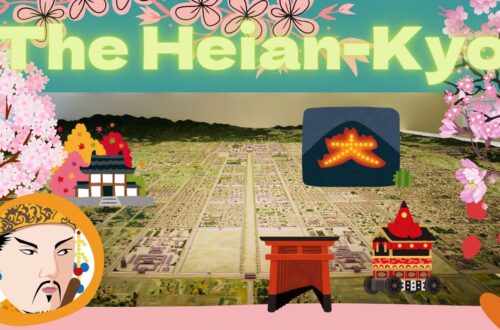
#16 The Mongol Invasions
Click here to go to the YouTube video

This episode is about The Mongol Invasions. Let’s look at how the Kamakura Shogunate responded to foreign invasions.
今回のテーマは元寇です。鎌倉幕府はその危機にどう対応したのでしょうか。

At the beginning of the 13th century, Genghis Khan established the Mongol Empire. The Mongol Empire established a cavalry army and ruled over a vast area that straddled the Eurasian continent.
13世紀はじめ、チンギス・ハンがモンゴル帝国を建国しました。モンゴル帝国は騎馬隊を組織しユーラシア大陸にまたがる広大な地域を支配しました。

Genghis Khan’s grandson, the fifth emperor, Kublai Khan, conquered China and founded the Yuan Dynasty. After conquering the Koryo Dynasty on the Korean peninsula, Kublai also attempted to subjugate Japan.
チンギス・ハンの孫で5代皇帝のフビライ・ハンは中国を征服し元王朝をたてました。フビライは朝鮮半島の高麗を征服した後、日本にも服属を求めてきました。

Envoys from Kublai came to Japan several times. At that time, the head of the Kamakura shogunate was Hojo Tokimune. Tokimune was very young but rejected the requests for submission and prepared for the invasion of the Yuan army.
フビライからの使者が何度も日本にやって来ました。当時の鎌倉幕府のリーダーは北条時宗でした。時宗はとても若かったのですが服属の要求をはねのけ、元軍の侵攻に備えました。

In 1274, a large Yuan army appeared in northern Kyushu. Japanese warriors fought bravely. However, they were troubled by the Yuan army’s mass warfare methods and the “tetsu-hau” explosive weapon.
1271年、元の大軍が北九州に現れました。日本の武士は果敢に戦いましたが、元軍の集団戦法や「てつはう」という火薬を使った武器に悩まされました。

Suddenly, however, a storm broke out and Yuan’s ships were destroyed, this led to the Yuan forces retreating. This is referred to as the Battle of Bun’ei.
しかし、突然、嵐が起こり、元軍の船団は破壊され、元軍は退却しました。これを文永の役といいます。

The following year, Yuan’s envoy came to Japan again and demanded subjugation. Tokimune had the envoy executed and prepared for the next battle. The fortifications built at this time still remain in Hakata, northern Kyushu.
翌年、元の使者が再び来日し、服属を要求しました。時宗は使者を処刑し、次の戦いに備えました。この時に建設された防塁は今も北九州の博多に残されています。

In 1281, Yuan invaded Japan with an even larger army than before. This time, however, the Japanese army successfully blocked the invasion and did not allow the Yuan forces to land. Then, once again, a storm occurred, devastating Yuan’s fleet. This is called the Battle of Koan.
1281年、元軍が前回よりもさらに大軍を率いて日本へ侵攻しました。しかし、今回は日本の武士たちは侵攻を食い止めることに成功し、元軍の上陸を許しませんでした。そして再び暴風雨が起こり元の船団を破壊しました。これを弘安の役と呼びます。

The people called the storm that saved them from two crises a kamikaze, or divine wind. Since that time, the belief was born that a kamikaze would blow and save the country in times of national crisis.
二度の危機を救った暴風雨を人々は「神風」と呼びました。この時以来、危機のときには神風が吹き国を救ってくれるという信仰が生まれました。

After winning the battles against the Yuan forces, Hojo Tokimune died at the young age of 34. He was buried at Engaku-Ji Temple in Kamakura. The Kamakura shogunate successfully defended Japan from foreign invasions. However, the economic damage caused by the war led to the decline of the Kamakura shogunate.
元軍との戦いに勝利した後、北条時宗は34歳という若さで亡くなり、鎌倉の円覚寺に葬られました。鎌倉幕府は外国の侵略から国を守ることに成功しましたが、戦争による経済的な損失が原因となり衰退していきました。
Thank you for reading.



